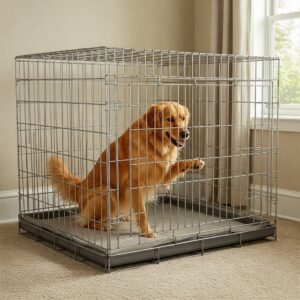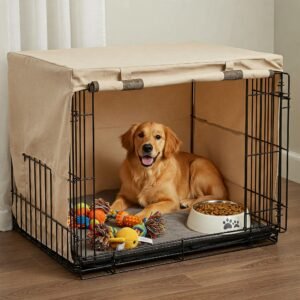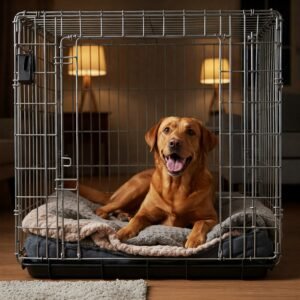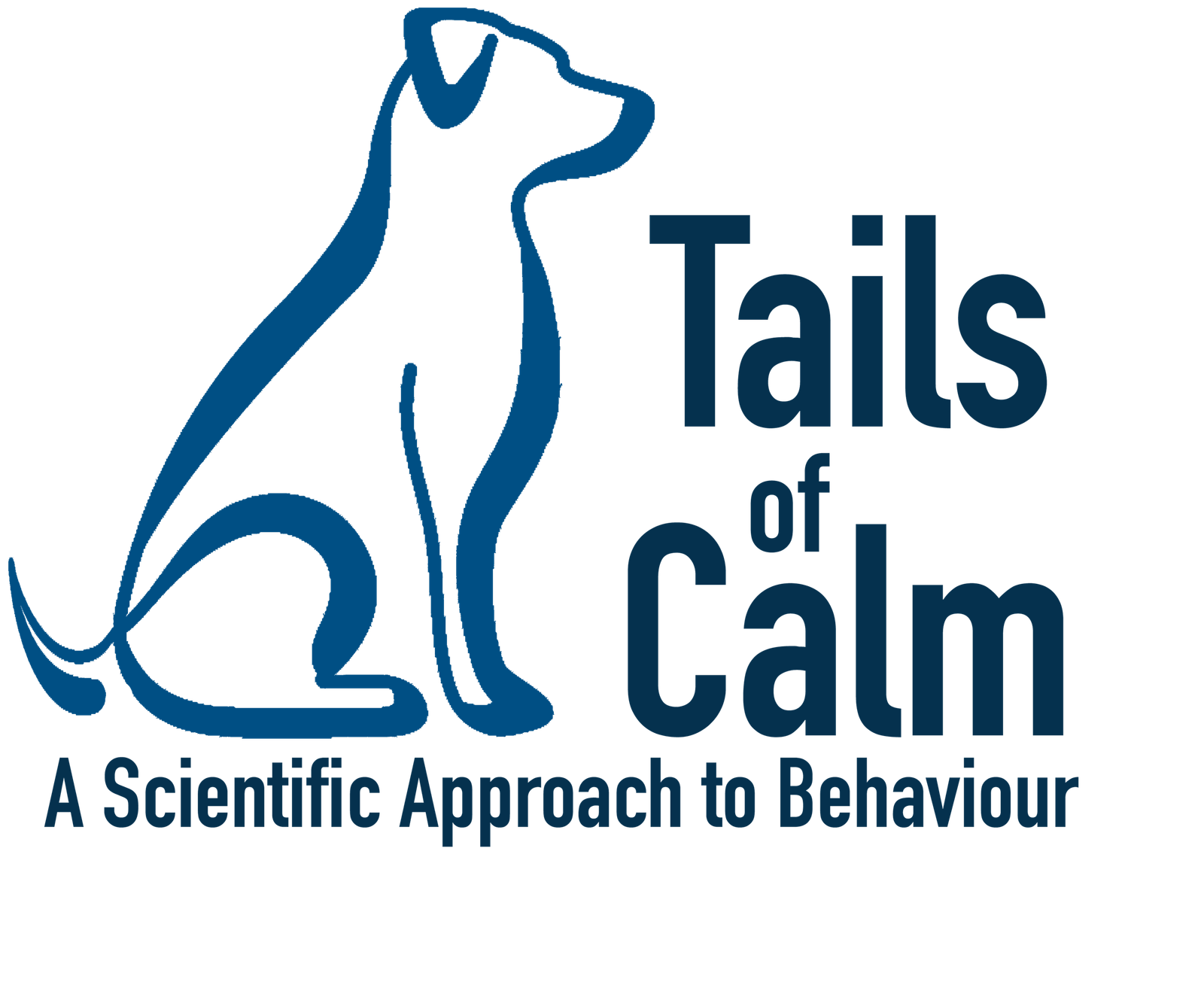Open-Door Policy: Safety without Confinement
Redefining Crate Utility to Foster Security, Autonomy, and Emotional Well-Being
K Miri
The Crate Debate—Safe Space or Confinement?
Crates are often seen as essential tools, commonly used alongside dog adoption in most North American households. Many guardians rely on crates for house training, preventing destructive behaviours, providing a designated resting area, or ensuring safety during travel. While crates can serve these functions effectively, their impact on a dog’s emotional well-being depends on how they are introduced and used.
The role of crates in dog care and training is complex, with varying perspectives on their proper use. A crate can function as a safe retreat, but it can also become a source of distress, depending on the circumstances. In this article, we examine the evidence on the effects of crates when used for extended confinement or as a strict management tool. Research shows that excessive confinement can lead to stress, fear, anxiety, frustration, aggression, and even learned helplessness. We explore the psychological and physiological consequences of confinement and discuss how crate training can be improved through an Open-Door Policy, allowing dogs to voluntarily seek out their crate as a secure resting space rather than experiencing it as a restrictive enclosure.
Related Videos
Absence of Control and Psychological Distress
A dog’s ability to explore, make choices, and interact with its surroundings plays a crucial role in emotional stability and cognitive development. Dogs subjected to prolonged confinement often exhibit elevated physiological markers of stress, such as increased cortisol levels, and display stress-related behaviours like excessive barking, pacing, and reduced voluntary engagement with their environment (Coppola et al., 2006). These behavioural and physiological changes are largely attributed to the loss of control over their surroundings.
The ability to influence one’s environment is a fundamental component of well-being in both humans and animals. When dogs are confined without an option to remove themselves from stressful situations—such as being crated for extended periods—they may experience heightened anxiety and distress. Over time, this lack of control can lead to learned helplessness, a psychological state in which an animal ceases trying to escape or solve problems due to repeated experiences where their actions had no effect (Protopopova & Wynne, 2015). Research has shown that dogs confined for long durations may exhibit withdrawal, passivity, or reduced problem-solving behaviours—not as signs of adaptation, but as indications of emotional suppression.
Manifestation of Crate Stress in Everyday Life
The effects of confinement do not simply end when a dog is released from a crate; rather, they can spill over into daily interactions and behaviour. Stress accumulated during confinement can influence problem-solving ability, emotional resilience, and overall adaptability, shaping how a dog copes with challenges in their environment.
Loss of Control and Problem-Solving Deficits: Crate confinement can impair a dog’s cognitive flexibility by limiting their exposure to new challenges and reducing opportunities for independent decision-making. When a dog repeatedly fails to escape an inescapable crate, they may learn that their actions have no effect, leading to a diminished willingness to engage in problem-solving in other situations. Over time, this loss of control can make dogs more prone to frustration, withdrawal, or passivity. In contrast, dogs who regularly encounter decision-making opportunities and problem-solving tasks develop emotional resilience, enabling them to adapt more effectively to their surroundings and handle stress in a healthier way.
Crate Frustration, Trigger Stacking and the Behavioural Feedback Loop: Dogs exhibiting physiological and behavioural stress responses inside the crate often display spillover effects once released. The phenomenon of trigger stacking—where multiple stressors accumulate, leading to an exaggerated response—can cause dogs to overreact to seemingly minor stimuli. A dog who has endured repeated frustration and loss of control in confinement may become more reactive outside the crate, displaying behaviours such as:
Excessive barking and lunging at people or other animals.
Destructive tendencies, such as chewing furniture, scratching doors, or tearing household items.
Hyperactivity, difficulty settling, or impulsivity.

Crate Frustration, Trigger Stacking and the Behavioural Feedback Loop: Dogs exhibiting physiological and behavioural stress responses inside the crate often display spillover effects once released. The phenomenon of trigger stacking—where multiple stressors accumulate, leading to an exaggerated response—can cause dogs to overreact to seemingly minor stimuli. A dog who has endured repeated frustration and loss of control in confinement may become more reactive outside the crate, displaying behaviours such as:
Excessive barking and lunging at people or other animals.
Destructive tendencies, such as chewing furniture, scratching doors, or tearing household items.
Hyperactivity, difficulty settling, or impulsivity.
The HPA Axis and Stress: Understanding the Physiological Impact of Confinement:
The Hypothalamic-Pituitary-Adrenal (HPA) axis is the body’s central stress response system, regulating how animals perceive and react to challenges (Hawkley et al., 2012). This complex neuroendocrine system governs the release of cortisol, the primary stress hormone, which helps animals adapt to environmental stressors. When a dog encounters a stressor, the hypothalamus signals the pituitary gland, which then triggers the adrenal glands to release cortisol (Hawkley et al., 2012). In a well-functioning system, cortisol levels temporarily rise to help the body respond to the stressor, then decrease once the challenge has passed (Protopopova & Wynne, 2015).
Acute Stress and the HPA Axis: In short-term or acute stress situations, the activation of the HPA axis is adaptive. The temporary elevation of cortisol enhances alertness, energy mobilization, and cardiovascular function, preparing the animal to cope with the immediate challenge. Once the stressor is removed, negative feedback mechanisms regulate the system, bringing cortisol levels back to baseline. This transient stress response is crucial for survival and does not necessarily lead to long-term negative effects if the system remains well-regulated.
Chronic Stress and HPA Axis Dysregulation: A dog experiencing chronic, uncontrollable stress—such as prolonged confinement or social isolation— results in the overactivation of the HPA axis, leading to persistent cortisol elevation and dysregulation (Uetake et al., 2016). Unlike the adaptive short-term stress response, chronic activation of this system can lead to:
- Weakened coping mechanisms, making it harder for dogs to recover from future stressors.
- Increased anxiety and hypervigilance, reducing their ability to relax, even in safe environments.
- Behavioural withdrawal, where dogs show reduced engagement with their surroundings.
- Physiological stress markers that remain elevated, even when outward signs of distress fade (Hawkley et al., 2012).
Research on confined dogs has demonstrated that even when behavioural signs of distress diminish, physiological indicators of stress often remain elevated, suggesting that the dog has not fully adapted but is instead in a prolonged state of stress regulation dysfunction (Coppola et al., 2006; Hawkley et al., 2012). Chronic cortisol elevation has also been associated with:
- Immune suppression, increasing susceptibility to illness.
- Muscle wasting and metabolic disturbances, impacting physical well-being.
- Heightened reactivity, making dogs more prone to exaggerated stress responses and behavioural instability.
 When destructive or undesirable behaviours emerge, many guardians interpret them as misbehaviours that need to be “fixed” rather than a stress response that needs to be investigated. This often results in increased crate time as a form of management, reinforcing a harmful feedback loop.
When destructive or undesirable behaviours emerge, many guardians interpret them as misbehaviours that need to be “fixed” rather than a stress response that needs to be investigated. This often results in increased crate time as a form of management, reinforcing a harmful feedback loop.
- Crate frustration leads to destructive behaviour
- Guardian frustration leads to longer crate confinement
- Increased crate time worsens stress and behavioural issue
- Escalation to heightened reactivity, separation anxiety, and other anxiety-driven behaviours.
Over time, the cycle of restriction and stress intensifies, making behaviour modification more challenging. Training alone often fails to resolve these issues because the root cause—chronic stress and loss of control—remains unaddressed.
Lasting Behavioural Consequences: Confinement-induced frustration can also increase a dog’s sensitivity to everyday stimuli, making them more likely to overreact to sudden noises, unfamiliar people, or environmental changes. Additionally, dogs who have spent extended periods in restrictive spaces may develop:
Impulse control difficulties, struggling to regulate excitement or frustration.
Over-attachment or separation anxiety, becoming overly reliant on their guardian yet distressed when left alone.
Displaced aggression, where frustration is redirected toward objects, other animals, or even people.
Recognizing these behavioural manifestations is essential for ensuring that dogs receive appropriate stress relief, opportunities for autonomy, and an environment that promotes resilience rather than emotional suppression.
Manifestation of Confinement Stress
In-crate:
- Excessive Barking or Whining – Vocalizations that signal frustration, anxiety, or attempts to seek attention.
- Pacing or Repetitive Movement – Walking in circles or back and forth, a common sign of stress and lack of mental stimulation.
- Reduced Social and Environmental Engagement – Withdrawal from human interaction or reluctance to explore surroundings.
- Compulsive Behaviors – Excessive licking, chewing, or biting at their body, often linked to frustration or anxiety.
- Escape Attempts – Scratching, digging, or biting at barriers in an attempt to leave the confined space.
- Panting and Restlessness – Physiological signs of stress even in the absence of heat or exercise.
- Elimination in the Crate or Enclosure – Accidents despite prior house training, often due to stress-related lack of control.
- Freezing – Appearing overly quiet or motionless, signaling a lack of response to the environment.
- Learned Helplessness – A psychological state where the dog stops attempting to change its situation, indicating emotional suppression rather than true relaxation.
Out-of-crate:
Out-of-Crate Misbehaviors Due to Trigger Stacking – Increased sensitivity to external stimuli, leading to overreactions such as excessive barking, lunging, or destructive behavior once released from confinement.
Heightened Reactivity – Stronger responses to perceived threats, such as sudden noises or unfamiliar people, due to accumulated stress.
Impulse Control Issues – Difficulty regulating excitement or frustration, often manifesting as jumping, mouthing, or hyperactive behavior.
Over-Attachment or Separation Anxiety – Excessive clinginess or distress when separated from a guardian, driven by the unpredictability of confinement.
Displaced Aggression – Redirected frustration toward objects, people, or other animals as a coping mechanism for prolonged stress.

Calm or Shut Down? The Misinterpretation of Behaviour in Confined Dogs
Crate training is often assessed based on outward behaviour—if a dog stops whining, barking, or struggling, it is commonly assumed that they have “settled down.” However, behavioural science suggests that a quiet, still dog inside a crate may not be relaxed, but rather in a state of behavioural shutdown. This misinterpretation is critical because it can lead to unintentional welfare neglect, where dogs experiencing chronic stress and emotional suppression are mistaken for being well-adjusted.
It is critical to distinguish between true adaptation and behavioural shutdown. Dogs in long-term confinement often exhibit reduced activity and fewer overt stress signals, leading some to mistakenly assume they are “settling down.” However, research on elderly shelter dogs and long-term kenneling has found that while movement and vocalization decrease, stress markers such as corticosterone levels remain high (Uetake et al., 2016). This suggests that the absence of stress-related behaviours does not indicate comfort, but rather a shift towards passivity and emotional suppression.
This misinterpretation is further supported by Seligman & Maier’s (1967) shuttle box experiments, which demonstrated that dogs previously exposed to inescapable shocks stopped attempting to escape—even when escape later became possible. Their stillness was not calmness—it was learned helplessness. This has profound implications for crate training outcomes, as an unmoving or quiet dog may not be relaxed, but psychologically shut down due to repeated stress exposure.
When a dog is repeatedly exposed to an uncontrollable or inescapable stressor, they may exhibit initial signs of distress—whining, barking, panting, or attempting to escape. If these behaviours fail to change the outcome, the dog may transition into a passive coping strategy, appearing subdued and still. While this may seem like “calm” behaviour, it is actually a sign of behavioural suppression, a response commonly observed in animals subjected to prolonged confinement or unpredictable environments (Protopopova & Wynne, 2015).
Research on long-term kenneling and shelter housing has shown that dogs often exhibit reduced movement and vocalization over time, but their physiological stress markers—such as elevated cortisol and corticosterone levels—remain high (Uetake et al., 2016). This indicates that these dogs are not truly relaxed; rather, their stress response system is still active, but their outward expression of distress has diminished.
The HPA Axis and Stress: Understanding the Physiological Impact of Confinement
The Hypothalamic-Pituitary-Adrenal (HPA) axis is the body’s central stress response system, regulating how animals perceive and react to challenges (Hawkley et al., 2012). This complex neuroendocrine system governs the release of cortisol, the primary stress hormone, which helps animals adapt to environmental stressors. When a dog encounters a stressor, the hypothalamus signals the pituitary gland, which then triggers the adrenal glands to release cortisol (Hawkley et al., 2012). In a well-functioning system, cortisol levels temporarily rise to help the body respond to the stressor, then decrease once the challenge has passed (Protopopova & Wynne, 2015).

Acute Stress and the HPA Axis: In short-term or acute stress situations, the activation of the HPA axis is adaptive. The temporary elevation of cortisol enhances alertness, energy mobilization, and cardiovascular function, preparing the animal to cope with the immediate challenge. Once the stressor is removed, negative feedback mechanisms regulate the system, bringing cortisol levels back to baseline. This transient stress response is crucial for survival and does not necessarily lead to long-term negative effects if the system remains well-regulated.
Chronic Stress and HPA Axis Disregulation: A dog experiencing chronic, uncontrollable stress—such as prolonged confinement or social isolation— results in the overactivation of the HPA axis, leading to persistent cortisol elevation and dysregulation (Uetake et al., 2016). Unlike the adaptive short-term stress response, chronic activation of this system can lead to:
Weakened coping mechanisms, making it harder for dogs to recover from future stressors.
Increased anxiety and hypervigilance, reducing their ability to relax, even in safe environments.
Behavioural withdrawal, where dogs show reduced engagement with their surroundings.
Physiological stress markers that remain elevated, even when outward signs of distress fade (Hawkley et al., 2012).
Research on confined dogs has demonstrated that even when behavioural signs of distress diminish, physiological indicators of stress often remain elevated, suggesting that the dog has not fully adapted but is instead in a prolonged state of stress regulation dysfunction (Coppola et al., 2006; Hawkley et al., 2012). Chronic cortisol elevation has also been associated with:
Immune suppression, increasing susceptibility to illness.
Muscle wasting and metabolic disturbances, impacting physical well-being.
Heightened reactivity, making dogs more prone to exaggerated stress responses and behavioural instability.
What Makes a Crate a True Safe Space?
A crate can serve as a secure, comforting retreat for a dog, but only when it is truly a safe space—free from restriction and stress. Many dogs naturally seek out enclosed areas to rest, provided they associate the space with security rather than forced confinement. Here the key elements of a true Safe space:

Choice to Freely Enter and Exit: A safe space is never a forced space. The most critical aspect of a secure crate environment is that the dog has the freedom to enter and exit voluntarily. Dogs that willingly use their crate are demonstrating true comfort, whereas dogs confined against their will may exhibit signs of stress, frustration, or eventual learned helplessness. A crate should not function as a tool for control but rather as a designated retreat that meets the dog’s emotional and physical needs.
Positive Associations: Research on classical conditioning in animal training highlights the importance of pairing neutral spaces with rewarding experiences to create positive emotional connections (Panksepp, 1998). Dogs should associate their crate with safety, predictability, and comfort rather than a place where they are restricted. Dogs form lasting associations with their environment, so ensuring that the crate is linked to positive experiences is key. A true safe space includes:
- Comfortable bedding that supports relaxation (this should be adjusted based on the dog’s preference—some dogs may find plush bedding aversive and prefer a cool, smooth surface instead).
- Enrichment items, such as chew toys or puzzle feeders, that engage the mind (only if the dog finds them enjoyable and has previously made positive associations with the items—if ignored or avoided, they should be reassessed or removed).
- Encouragement to use the crate, never force or punishment.
- Training sessions that reinforce positive emotions, such as feeding meals inside the crate while the door remains open.
Consistency and Predictability: Studies on environmental predictability in shelter dogs have shown that animals housed in consistent, structured environments exhibit lower stress levels than those in unpredictable settings (Hennessy et al., 1997). Similarly, when used correctly, a crate should provide a stable, dependable sanctuary rather than an unpredictable experience tied to isolation or separation. A dog’s environment should be predictable to foster emotional stability. If a crate is sometimes used as a resting area but at other times becomes a place of forced isolation, the conflicting experiences may create uncertainty and anxiety. Instead, a true safe space follows these guidelines:
- The crate is always a positive, low-stress environment—never a punishment.
- Dogs can reliably retreat to their crate when seeking rest or alone time.
- Routine use builds trust, ensuring that the dog understands when and how the crate will be used.
Your Guide For Choosing the Right Crate
Selecting the right crate is essential to ensuring that it serves as a true safe space rather than a restrictive enclosure. The type, size, and setup of the crate play a major role in how comfortable and secure a dog feels inside it.
Size Matters – Space for Movement: A crate should be large enough for the dog to stand up fully, turn around, and move comfortably. Cramped spaces can contribute to discomfort, stress, and reduced willingness to use the crate voluntarily.
Why Metal Crates Are Recommended: Metal wire crates are often the best option because they:
- Allow for proper airflow, preventing the crate from becoming stuffy.
- Do not retain moisture, reducing the risk of mold buildup.
- Are easy to clean and sanitize, ensuring long-term hygiene.Plastic crates, while suitable for travel, can become stuffy and less ventilated, making them less ideal for long-term use indoors.
Suggestion: Plastic crates, while suitable for travel, can become stuffy and less ventilated, making them less ideal for long-term use indoors.
Crate Covers – Privacy Without Isolation: Dogs feel more secure in partially covered crates, which mimic a cozy den-like environment. A breathable, washable cover (such as a blanket or fabric matching the home’s furniture) can help provide this sense of security.
- The front of the crate should remain open, allowing the dog to see their surroundings and not feel trapped.
- The sides and top should be covered, helping reduce visual stimuli and create a calm retreat space.
- Covers should be made from breathable materials to ensure proper airflow.
- Secure the cover properly to prevent it from slipping or obstructing airflow.
Suggestion: If a dog is hesitant about a fully covered crate, start by covering just the top and gradually drape the sides over time as they adjust.
Bedding – Comfort Based on Individual Preference: Not all dogs have the same preferences for bedding. Some prefer plush, cushioned beds, while others may be more comfortable on a firm surface or a cooling mat. The best bedding choice is the one that the dog actively seeks out and enjoys.
Crate Placement – Creating a Secure and Functional Space: The crate should be placed in a quiet but social area—not completely isolated, but also away from excessive foot traffic. Ideally, it should be in a spot where the dog can observe household activities from the front opening, while the covered sides create a feeling of security and retreat.
Avoid placing the crate near:
- Direct heat sources (radiators, fireplaces)
- Cold drafts (windows, air vents)
- Noisy appliances (washing machines, loud speakers)
Suggestion: For multi-dog households, each dog should have their own crate to prevent stress or resource guarding, and crates should be spaced apart to allow each dog to feel secure.
Looking Beyond the Crate: Behaviour as a Continuum
Crate training, when done correctly, can provide dogs with a safe, secure space that supports their emotional and physical well-being. However, as research on stress, autonomy, and behavioural welfare has shown, a crate should never be a place of restriction or forced confinement. When used inappropriately, crates can lead to chronic stress, learned helplessness, and emotional suppression, undermining a dog’s ability to thrive.Behaviour inside the crate cannot be assessed in isolation. Dogs do not compartmentalize stress—behaviours exhibited outside of the crate, such as separation anxiety, noise phobias, reactivity, aggression, and generalized stress, may be directly linked to the inappropriate use of confinement. If a guardian struggles with modifying these behaviours despite consistent training, it is crucial to assess whether chronic stress from crate use is contributing to a heightened stress response and an inability to self-regulate.
This is why addressing a dog’s behaviour holistically is essential. Following rigid training protocols that treat only the symptom rather than the underlying cause can be detrimental to a dog’s well-being and long-term behavioural resolution. Instead of focusing solely on surface-level behaviours, we must consider the entire context of a dog’s environment, past experiences, and emotional needs.
Breaking the Cycle-A Proactive Approach to Preventing Crate-Induced Stress:
When a dog experiences chronic stress and frustration inside the crate, the behavioural consequences do not stay confined to that space. Instead, they spill over into everyday life, shaping how the dog reacts to challenges, new experiences, and routine interactions. Without intervention, this can create a self-reinforcing cycle, where crate-induced distress leads to more behavioural issues, increased confinement, and worsening emotional instability.
Many guardians unintentionally become caught in this vicious loop:
- A dog experiences stress and frustration in the crate, leading to increased restlessness and pent-up energy.
- Once released, the dog engages in destructive or hyperactive behaviours (e.g., chewing furniture, barking excessively, tearing household items) as a stress outlet.
- The guardian, frustrated by these behaviours, increases crate time to prevent further destruction.
- Longer crate time aggravates stress and anxiety, reinforcing reactivity, separation anxiety, excessive vocalization, and even aggression.
Instead of resolving the issue, this approach amplifies the root cause—chronic stress, lack of autonomy, and an inability to self-regulate. Training alone may fail to correct these behaviours if the underlying stress cycle remains unaddressed. To prevent this self-perpetuating loop, it’s essential to:
- Recognize that destructive behaviours often stem from crate frustration, not defiance.
Dogs do not destroy furniture or act out due to stubbornness—they do so as an outlet for pent-up stress and a lack of mental and physical stimulation. - Avoid using the crate as a default management tool for unwanted behaviours.
A crate should not be a reactionary measure to prevent destruction or hyperactivity—it should be a voluntary space for rest and security. Increasing crate time to manage stress-related behaviours only worsens them. - Provide sufficient mental and physical enrichment outside the crate.
Frustration-based behaviours often stem from unmet needs. Daily activities like puzzle feeders, scent work, interactive play, and structured walks help prevent crate frustration from manifesting in destructive or reactive behaviours. - Encourage self-regulation by offering choices.
Dogs should have opportunities to make choices throughout their day—including when to enter and exit the crate. When autonomy is respected, frustration-driven responses are significantly reduced. - Implement the Open-Door Policy, ensuring that the crate remains a safe retreat, not a place of forced confinement.
By allowing dogs to choose when to rest inside the crate, we shift from confinement-based management to choice-driven training, which supports emotional resilience and stress recovery.
By addressing the root cause of crate-related frustration, we prevent behavioural fallout, reduce reactivity, and create a calmer, more emotionally stable companion.

Concluding Remarks
The Open-Door Policy represents a shift in how we approach crating—not as a means of control, but as a voluntary refuge. A crate should function as a safe space where a dog chooses to rest, rather than being confined for extended periods. This approach is grounded in science and ethics, recognizing that true security comes from autonomy, positive associations, and predictability—not from forced stillness.
Does your dog’s crate function as a true safe space, or could adjustments be made to improve their comfort and autonomy?
What small changes can you implement today to transform your dog’s crate into a secure, stress-free retreat?




